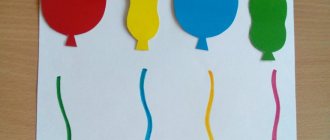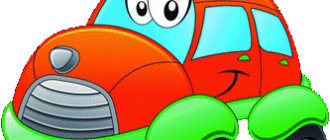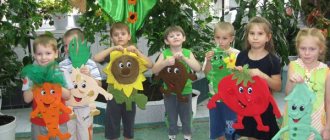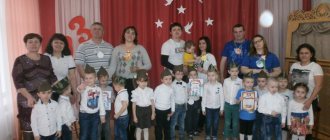Card index of games for social and communicative development in the middle group
Sukhobokova Olga
Card index of games for social and communicative development in the middle group
Card index of games for social and communicative development in the middle group.
"Name yourself"
Goal: To develop the ability to present oneself to a group of peers.
The child is asked to introduce himself, saying his name as he likes best, as he would like to be called in the group .
"Call me kindly"
.
Goal: to cultivate a friendly attitude among children towards each other.
The child is asked to throw a ball or pass a toy to a favorite peer (optional)
affectionately calling him by name.
"Magic Chair"
.
Goal: to cultivate the ability to be affectionate, to activate gentle, affectionate words in children’s speech.
One child sits in
, and the rest say kind, affectionate words about him.
"Magic wand"
.
Goal: continue to develop the ability to be affectionate.
Children stand in a circle. One child passes the stick to the person standing next to him and calls him affectionately.
"Freeze"
.
Goal: develop listening skills , develop organization .
The meaning of the game is in the teacher’s simple command “Freeze”
, which can be heard during children’s activities, in a variety of situations.
"Stream"
Goal: to develop the ability to act together and teach to trust and help those with whom you communicate.
Before the game, the teacher talks with the children about friendship and mutual assistance, about how they can overcome any obstacles. Children stand one after another and hold on to the shoulders of the person in front. In this position they overcome any obstacles.
Go around the lake, crawl under the table, etc.
"Magic wand"
.
Goal: developing ideas about the capabilities of one’s own and peers.
One names the fairy tale, another its characters, etc.
"Polite Words Store"
Goal: develop goodwill , the ability to establish contact with peers.
Educator: I have polite words on the shelf in my store: greetings (hello, good morning, good afternoon, etc.)
;
affectionate addresses (dear mommy, dear mommy, etc.)
.
I will offer you various situations, and you buy the right words from me.
Situation. Mom brought apples from the store. You really want to, but mom said you need to wait until lunch.
How do you ask her to give you an apple?
"Body"
.
Goal: Continue to reinforce polite words.
Children sit around a table on which there is a basket. The teacher turns to the child: “Here’s a box for you, put a polite word in it.”
.
"That's what grandma is like"
Goal: develop respect for elders , reinforce kind words.
Each child takes turns telling what his grandmother’s name is, and how affectionately you can call her.
"Wonderful bag"
Goal: expanding the volume of vocabulary, developing tactile perception and ideas about the characteristics of objects.
Children take turns recognizing the object by touch, naming it, and taking it out of the bag.
"Good words"
.
Goal: to develop the ability to use kind words in speech.
Children choose kind words. Show the children a picture of children working. What can you call children who work? (Hardworking, active, kind, noble, etc.)
"Rug of Reconciliation"
.
Goal: develop communication skills and conflict resolution skills.
Coming from a walk, the teacher tells the children that two boys quarreled over a toy. Invites you to sit down opposite each other on the “rug of reconciliation”
find out the cause of the discord and find a way to peacefully resolve the problem. Discuss how to share the toy.
“What to do, what to do?”
Goal: to awaken children’s initiative, independence, intelligence, responsiveness, and willingness to look for the right solution.
Create a situation: there are no paints of certain colors, there is not enough plasticine for modeling. Children look for solutions on their own.
"Package"
Goal: expanding the volume of the dictionary, developing coherent speech .
The child receives a package from Santa Claus and begins to describe his gift without naming or showing it. The item is presented after the children have guessed it.
“This is what Santa Claus is like”
Goal: develop respect , reinforce kind words.
The child tells what gifts Santa Claus brought, how he thanked him, and how you can affectionately call him.
"Without a mask"
Goal: develop the ability to share your feelings, experiences, and construct unfinished sentences.
The teacher says the beginning of the sentence, the children must finish.
What I really want is...
I especially like it when...
One day I was very frightened by...
"Day Night"
Goal: develop the ability to collaborate and achieve the desired result.
After the words “The day comes - everything comes to life”
The participants in the game move chaotically and jump. When the teacher says:
“Night comes, everything freezes
,” the children freeze in bizarre poses.
“Listen outside the window, outside the door”
Goal: develop auditory attention .
As instructed by the teacher, all children focus their attention on the sounds and rustles of the corridor. Then they take turns listing and explaining what they heard.
"Who better to praise"
Goal: to be able to name the characteristics of animals based on the example of an adult, to develop attention and the ability to describe.
The teacher takes a bear for himself and gives the child a bunny.
And he begins: “I have a bear.”
Child:
“And I have a hare.”
etc.
"Who am I talking about"
Goal: to develop observation skills , the ability to focus on the main features of the described object.
The teacher describes the child sitting in front of him, naming his details of clothing and appearance. For example: “This is a girl, she is wearing a skirt and blouse, her hair is blond, her bow is red. She loves to play with the Tanya doll."
"That's what dad is like"
.
Goal: develop respect for dad , reinforce kind words.
The child tells what his dad’s name is, how he plays with him, how he affectionately calls him.
"Describe a friend"
.
Goal: to develop attentiveness and the ability to describe what you saw.
Children stand with their backs to each other and take turns describing their partner’s hairstyle, clothes, and face. Then the description is compared with the original and a conclusion is drawn about how accurate the child was.
“That’s what mom is like”
.
Goal: develop love for mom , reinforce kind words.
Each child takes turns telling what his mother’s name is, how she takes care of him, and how she can be affectionately called.
"What changed?"
.
Goal: attentiveness and observation necessary for effective communication.
The driver leaves the group . During his absence, several changes are made the group (children’s hairstyle, clothes, you can move to another place)
but no more than two or three changes.
"A gift for everyone"
Goal: develop a sense of teamwork , the ability to make friends, and make the right choice to cooperate with peers.
The children are given the task: “If you were a wizard and could work miracles, what would you give to all of us now?”
"Why"
.
Goal: develop the ability to be friends and be polite.
For example, if a girl is offended, she will cry.
If you accidentally pushed, then...
You were given a toy, then...
"Beat the transformation"
Goal: to cultivate trust in each other, a sense of responsibility for the other.
The teacher passes an object (a ball, a cube) in a circle, calling them by conventional names. Children act with them as if they were objects named by an adult. For example, they pass a ball in a circle. The leader calls it “Apple”
- children
“wash”
,
“eat”
,
“sniff”,
etc.
"Toys Alive"
.
Goal: to form a culture of communication in children.
Educator. You've probably been told or read fairy tales about how toys come to life at night. Please close your eyes and imagine your favorite toy, imagine what it does when it wakes up at night. Introduced? Then I suggest you play the role of your favorite toy. And we’ll try to guess what kind of toy you were depicting.
"Edible - inedible"
Goal: development of auditory attention , development of the ability to highlight the essential features of an object (edibility, animation)
.
The leader says the word and throws a ball to one of the children and names the object. If edible, the player catches the ball, and if inedible, the player dodges the ball.
"Magic wand"
.
Goal: to form ideas about the capabilities of one’s own and peers, to consolidate the signs of spring.
Children pass the stick and name the signs of spring.
"Let's say hello"
.
Goal: to create a psychologically relaxed atmosphere in the group .
The teacher and children talk about different ways of greeting, real and comic. Children are encouraged to greet with their shoulder, back, hand, nose, cheek and come up with their own way of greeting.
"What can happen?"
.
Goal: develop imagination , strengthen the ability to finish a sentence, and the ability to listen to each other.
What could happen if...
“All fairy-tale heroes will come to life”
.
"The rain will continue to fall"
.
Card file of problem situations for middle group children
Petkunova Karina Mikhailovna
Card file of problem situations for middle group children
1. "Who needs what"
— consolidate
children’s knowledge about objects needed by people of different professions: doctor, cook, salesman.
Progress of the game: the teacher invites the child to find an item necessary for the work of a doctor (cook, seller)
.
2. "If You're Lost"
— introduce
children to the rules of behavior in the current situation .
3. “If someone gets sick”
Goal: to consolidate the knowledge that in case of a serious injury it is necessary to call an ambulance doctor by calling number “03”, to practice calling a doctor.
Progress of the game: If we ourselves cannot cope with the situation , then we call a doctor or an ambulance. Children are asked to call a doctor at home. First, dial the phone number and call it in order: last name, first name -> address -> age -> complaints.
4. "Transport"
. The animals of Africa ask Aibolit for help, but Aibolit does not know how to get to them.
5. «Means of communication»
— The baby elephant’s grandmother got sick. We need to call a doctor, but he doesn’t know how.
children's play ideas and skills , create a desire to organize role-playing games. Help in choosing attributes.
6. "At home"
,
“Properties of Materials”
The piglets want to build a strong house to hide from the wolf and do not know what material to make it from.
7. “How and why does water flow?”
- formation in
children of knowledge that water flows from different vessels in different ways: from a wide one - in a large stream, from a narrow one - in a thin stream;
splashes fly from the outlets; water takes the shape of the vessel into which it is poured. 8. “What happened to the bunny?”
— to form an idea of humane treatment of animals;
develop emotional responsiveness, the desire to participate in solving problem situations .
9. Activating communication (solving problem situations )
on the topic
“What would you do if...?”
10. “Name it correctly”
— clarify
children’s knowledge about vegetables and fruits , their qualities (color, shape, taste),
consolidate the ability to recognize them and give a brief description.
11. “There is one toy, but there are many of us”
- promote the development of negotiation skills.
12. "If someone gets hurt"
— continue to introduce
children to basic first aid techniques.
13. “This way or that way”
— to develop
children’s to distinguish life-threatening situations from non-threatening ones ;
develop attention. 14. “They brought a new toy to the group , and everyone wants to play with it. What to do?" - cultivate a friendly attitude towards each other, teach to play together without taking toys away from each other, teach to share toys
15. "Who's there"
— discuss with children the rules of behavior in
the situation of a visit from a stranger, teach how and who to turn to for help.




